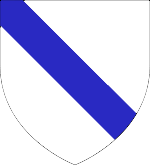
Baron Vernon, of Kinderton in the County of Chester, is a title in the Peerage of Great Britain. It was created in 1762 for the former Member of Parliament George Venables-Vernon. He had previously represented Lichfield and Derby in the House of Commons. Born George Vernon, he was the son of Henry Vernon, of Sudbury in Derbyshire, and Anne Pigott, daughter and heiress of Thomas Pigott by his wife Mary Venables, sister and heiress of Sir Peter Venables, Baron of Kinderton in Cheshire. In 1728, he assumed by Royal Licence the additional surname of Venables upon inheriting the Venables estate in Cheshire from his childless cousin Anne, widow of the 2nd Earl of Abingdon.

Alpraham is a village and civil parish in Cheshire, England, on the A51 road between Nantwich and Chester, seven miles north-west of Nantwich. The population is around 400.
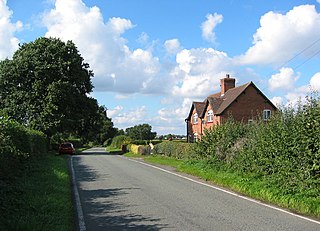
Blakenhall is a small village and civil parish in the unitary authority of Cheshire East and the ceremonial county of Cheshire, England, about 7 miles (11 km) south-east of Nantwich. It lies on the county boundary with Staffordshire. The parish has an area of 654 hectares and also includes the small settlements of The Den and Gonsley Green, with a total population of 125 in 2001. Nearby villages include Wybunbury in Cheshire and Betley and Wrinehill in Staffordshire. Blakenhall was first recorded in the Domesday survey as Blachenhale, and the parish had one of Cheshire's early ironworks in the 17th and 18th centuries. The area is rural and predominantly agricultural, with small areas of ancient woodland and the nature reserve of Blakenhall Moss, a rejuvenating lowland raised bog. The Crewe-to-Stafford railway line runs through the parish and it is on the proposed route of HS2.
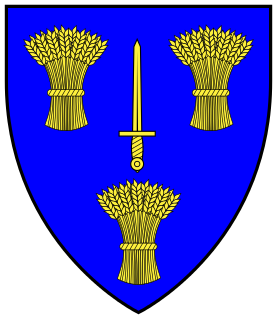
This is a list of Sheriffs of Cheshire.

St Luke's Church is in the village of Goostrey, Cheshire, England. It is recorded in the National Heritage List for England as a designated Grade II* listed building. It is an active Anglican parish church in the diocese of Chester, the archdeaconry of Macclesfield and the deanery of Congleton. Its benefice is combined with that of St Peter, Swettenham.
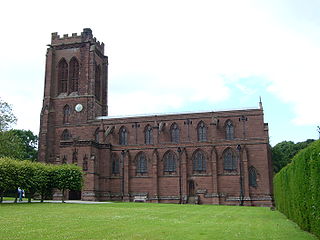
Eccleston is a village and former civil parish, now in the parish of Eaton and Eccleston, in the borough of Cheshire West, in the county of Cheshire, England. The village is approximately 2.7 miles (4.3 km) to the south of the city of Chester, near to the River Dee. The village is situated on the estate of the Duke of Westminster who maintains his ancestral home at nearby Eaton Hall.

Hartford is a village and civil parish in the unitary authority of Cheshire West and Chester and the ceremonial county of Cheshire, England. It lies at the intersection of the A559 road and the West Coast Main Line and is less than 2 miles (3.2 km) south west of the town of Northwich. It forms part of the Weaver Vale parliamentary constituency. According to the 2011 Census, the population of the parish was 5,558.

Little Leigh is a civil parish and village within the unitary authority of Cheshire West and Chester and the ceremonial county of Cheshire, England. It is situated on high ground on the north bank of the River Weaver; it is approximately 2 miles north of Weaverham on the A533 road and about three miles north-west of Northwich. The population of the civil parish taken at the 2011 census was 567.

George Venables-Vernon, 1st Baron Vernon, was a British politician.
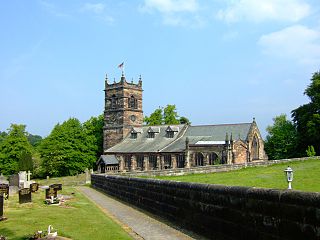
Rostherne is a civil parish and village in the unitary authority of Cheshire East and the ceremonial county of Cheshire, England.
Montagu Venables-Bertie, 2nd Earl of Abingdon PC, styled Hon. Montagu Bertie until 1682 and Lord Norreys from 1682 to 1699, was an English nobleman.

The Leghs of Lyme were a gentry family seated at Lyme Park in Cheshire, England, from 1398 until 1946, when the stately home and its surrounding parkland were donated by the 3rd Lord Newton to The National Trust.
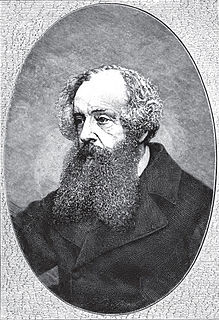
Egerton Leigh was a British landowner, soldier, Conservative politician and author.

Robert Venables, was an English soldier from Cheshire, who fought for Parliament in the 1638 to 1651 Wars of the Three Kingdoms, and captured Jamaica in 1655.

The Leghs of Adlington were established by Robert de Leigh who inherited the lordship of the manor of Adlington from his mother Elena de Corona. His father, John de Leigh, who was lord of the manor of Over Knutsford and seated at Norbury Booths, descended in the male line from the Venable family.
Peter Venables of Kinderton, Cheshire was an English politician who sat in the House of Commons at various times between 1640 and 1669. He supported the Royalist cause in the English Civil War.

The manor of Bradwall was a manorial estate in the parish of Bradwall near Sandbach in Cheshire, which dates back to the 13th century. Several families have been associated with either the manor, or the more recent country seat at Bradwall Hall.
Richard Newman, of Fifehead Magdalen, Dorset, was an important member of the ancient Newman family of Wessex, a barrister, High Steward of Westminster, Lord of Fifehead-Magdalen and Evercreech. He was also a Colonel in the Royalist forces during the English Civil War.
William Eure, 4th Baron Eure KB was an English nobleman.

